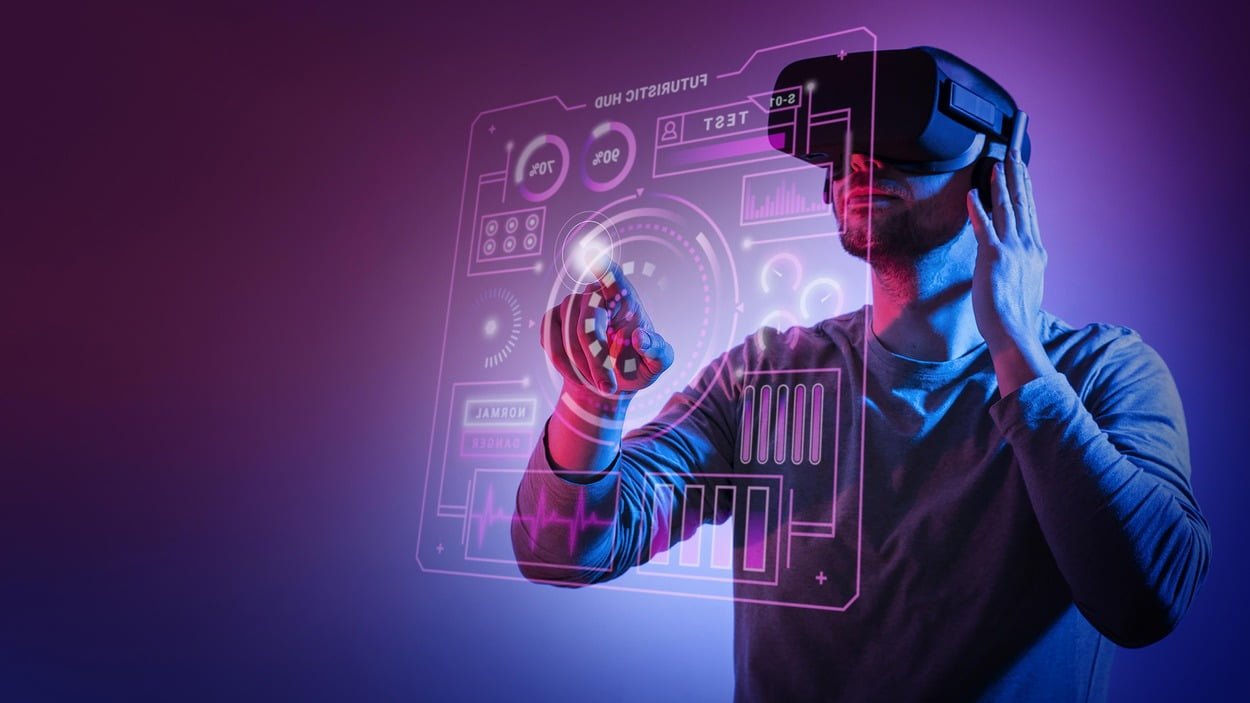Businesses are constantly seeking innovative ways to captivate their audience and stand out in a crowded market. Augmented Reality (AR) has emerged as a game-changer in the marketing landscape, offering unique and immersive experiences that can significantly enhance customer engagement and drive brand loyalty. This blog post delves into the fascinating world of AR in marketing, exploring its benefits, applications, and the tools needed to implement successful AR campaigns.

What is Augmented Reality (AR)?
Augmented Reality (AR) is a technology that overlays digital information, such as images, videos, or 3D models, onto the real world through devices like smartphones, tablets, and AR glasses. Unlike Virtual Reality (VR), which creates an entirely virtual environment, AR enhances the real-world experience by adding interactive digital elements.
The Benefits of AR in Marketing
1. Enhanced Customer Engagement
AR provides a unique and interactive way for customers to engage with your brand. By creating immersive experiences, AR captures the attention of users and keeps them engaged longer than traditional marketing methods.
2. Improved Brand Awareness
AR experiences are memorable and shareable, making them an excellent tool for increasing brand awareness. Customers are more likely to share their AR experiences on social media, amplifying your brand’s reach.
3. Personalized Experiences
AR allows for highly personalized marketing campaigns. By using AR, you can tailor experiences to individual users based on their preferences and behaviors, creating a deeper connection with your audience.
4. Increased Conversion Rates
Interactive AR experiences can drive higher conversion rates by allowing customers to visualize products in their real environment before making a purchase. This reduces uncertainty and boosts confidence in their buying decisions.
5. Competitive Advantage
Implementing AR in your marketing strategy can give you a significant edge over competitors who have yet to adopt this technology. It positions your brand as innovative and forward-thinking.
Applications of AR in Marketing

1. Product Visualization
One of the most common applications of AR in marketing is product visualization. AR enables customers to see how products will look and fit in their own environment. For example, furniture retailers can offer AR apps that allow users to place virtual furniture in their homes to see how it looks before making a purchase.
2. Interactive Advertising
AR can transform traditional advertisements into interactive experiences. Print ads, billboards, and packaging can be enhanced with AR elements that come to life when viewed through an AR app, providing additional information and engaging content.
3. Virtual Try-Ons
The fashion and beauty industries are leveraging AR to offer virtual try-ons. Customers can use AR apps to see how clothing, accessories, or makeup will look on them without physically trying them on, enhancing the online shopping experience.
4. AR Games and Contests
Brands can create AR games and contests to engage customers in a fun and interactive way. These experiences not only entertain but also encourage users to spend more time interacting with the brand.
5. Storytelling and Brand Experiences
AR can be used to tell compelling brand stories and create immersive brand experiences. For example, a brand can create an AR app that takes users on a virtual tour of their product’s journey from production to the consumer.
Tools for Implementing AR in Marketing

1. Spark AR Studio
- Overview: Developed by Facebook, Spark AR Studio allows you to create AR effects for Facebook and Instagram. It provides a user-friendly interface and a range of templates to get started.
- Website: Spark AR Studio
2. ARKit and ARCore
- Overview: ARKit (by Apple) and ARCore (by Google) are platforms for developing AR experiences on iOS and Android devices, respectively. They provide advanced tools and frameworks for building AR applications.
- Website: ARKit | ARCore
3. Zappar
- Overview: Zappar is an AR platform that allows you to create and publish AR experiences. It offers tools for building AR content and integrating it with various marketing channels.
- Website: Zappar
4. Blippar
- Overview: Blippar provides a comprehensive AR creation platform with tools for building, publishing, and analyzing AR experiences. It also offers solutions for retail, education, and advertising.
- Website: Blippar
5. Vuforia
- Overview: Vuforia is an AR development platform that provides a range of tools for creating AR applications. It supports a variety of devices and can be integrated with popular development environments like Unity.
- Website: Vuforia
How to Create an Effective AR Marketing Campaign
1. Define Your Goals
Before diving into AR, it’s crucial to define your marketing goals. Determine what you want to achieve with your AR campaign, whether it’s increasing brand awareness, boosting sales, or enhancing customer engagement.
2. Understand Your Audience
Understanding your target audience is essential for creating relevant and engaging AR experiences. Conduct market research to identify the preferences, behaviors, and needs of your audience.
3. Choose the Right AR Tool
Select an AR tool that aligns with your campaign goals and technical capabilities. Consider factors like ease of use, compatibility with your existing systems, and the level of customization offered.
4. Create Compelling Content
The success of your AR campaign hinges on the quality of your content. Invest in creating high-quality, interactive, and engaging AR experiences that resonate with your audience.
5. Promote Your AR Experience
Once your AR experience is ready, promote it across your marketing channels. Use social media, email marketing, and your website to drive awareness and encourage users to try your AR experience.
6. Measure and Optimize
After launching your AR campaign, track key performance metrics such as user engagement, conversion rates, and social shares. Use this data to optimize your campaign and improve future AR initiatives.
Case Studies: Successful AR Marketing Campaigns
1. IKEA Place
IKEA’s AR app, IKEA Place, allows customers to visualize how furniture will look in their homes. Users can place virtual furniture in their space using their smartphone, making it easier to make purchasing decisions. This innovative use of AR has significantly enhanced the shopping experience for IKEA customers.
2. Nike’s AR Try-On
Nike introduced an AR feature in its app that allows customers to virtually try on sneakers. By pointing their smartphone camera at their feet, users can see how different sneaker models will look on them. This feature has increased customer engagement and boosted online sales.
3. Pepsi Max’s AR Bus Shelter
Pepsi Max created an AR experience at a bus shelter in London, surprising commuters with realistic AR elements like a tiger walking down the street or an alien spaceship landing. This creative and unexpected use of AR generated significant buzz and social media shares.
Digital Sprig: Your Partner in AR Marketing
At Digital Sprig, we understand the power of augmented reality in transforming marketing strategies. Our team of experts is dedicated to helping businesses harness the potential of AR to create captivating and effective marketing campaigns. Here’s how we can assist you:
Custom AR Solutions
We offer tailored AR solutions to meet your specific business needs. Whether you need an AR app, an interactive advertisement, or a virtual try-on experience, we have the expertise to deliver high-quality AR content that resonates with your audience.
Integration and Deployment
Our team ensures seamless integration of AR experiences with your existing marketing channels and platforms. We handle the entire deployment process, ensuring your AR campaigns run smoothly and effectively.
Continuous Optimization
We provide ongoing support and optimization services to ensure your AR campaigns deliver the best results. By analyzing performance data and user feedback, we continually refine and enhance your AR experiences.
Training and Support
We offer comprehensive training and support to help you and your team make the most of your AR marketing efforts. From understanding AR tools to leveraging advanced features, we ensure you have all the knowledge and resources you need.
Conclusion
Augmented Reality is revolutionizing the marketing landscape by providing unique, immersive, and engaging experiences that captivate audiences and drive brand loyalty. By understanding the benefits of AR, exploring its applications, and utilizing the right tools, businesses can create effective AR marketing campaigns that stand out in a competitive market.
At Digital Sprig, we are committed to helping you navigate this exciting technology and implement successful AR strategies that elevate your brand. Contact us today to learn how we can help you harness the power of augmented reality in your marketing efforts.
By implementing the insights and strategies outlined in this blog post, you can leverage the power of augmented reality to enhance your marketing campaigns and achieve your business goals. Let Digital Sprig be your partner in this transformative journey. Visit Digital Sprig to learn more and get started.


